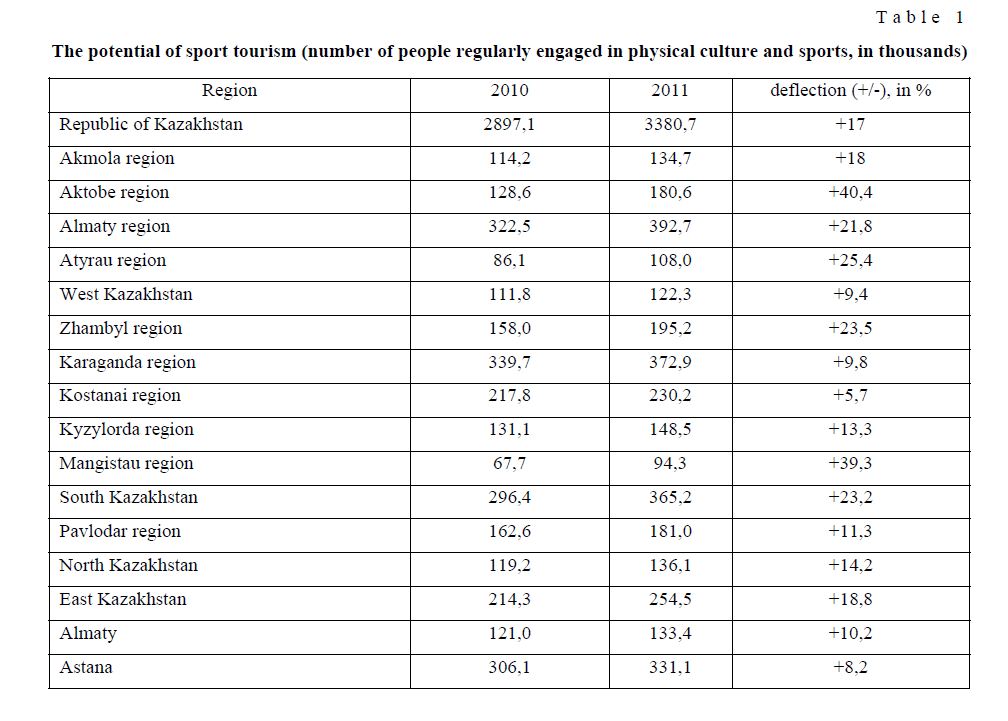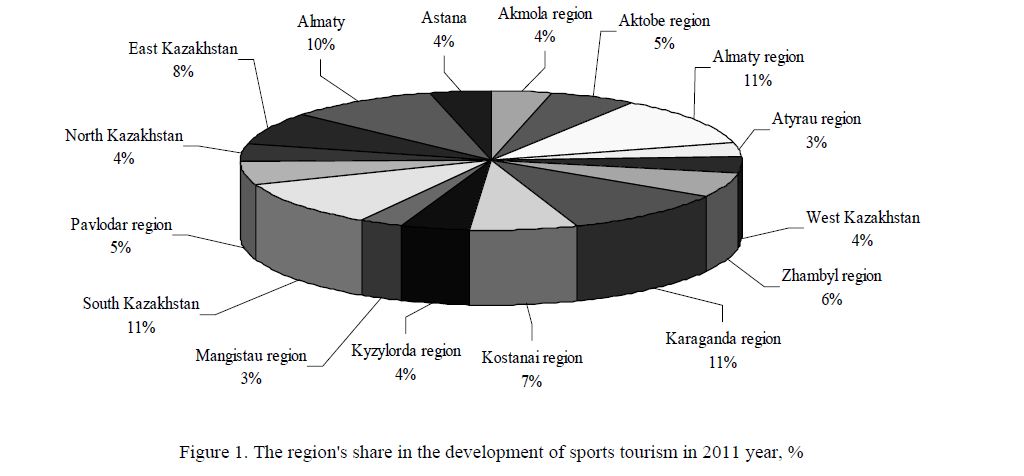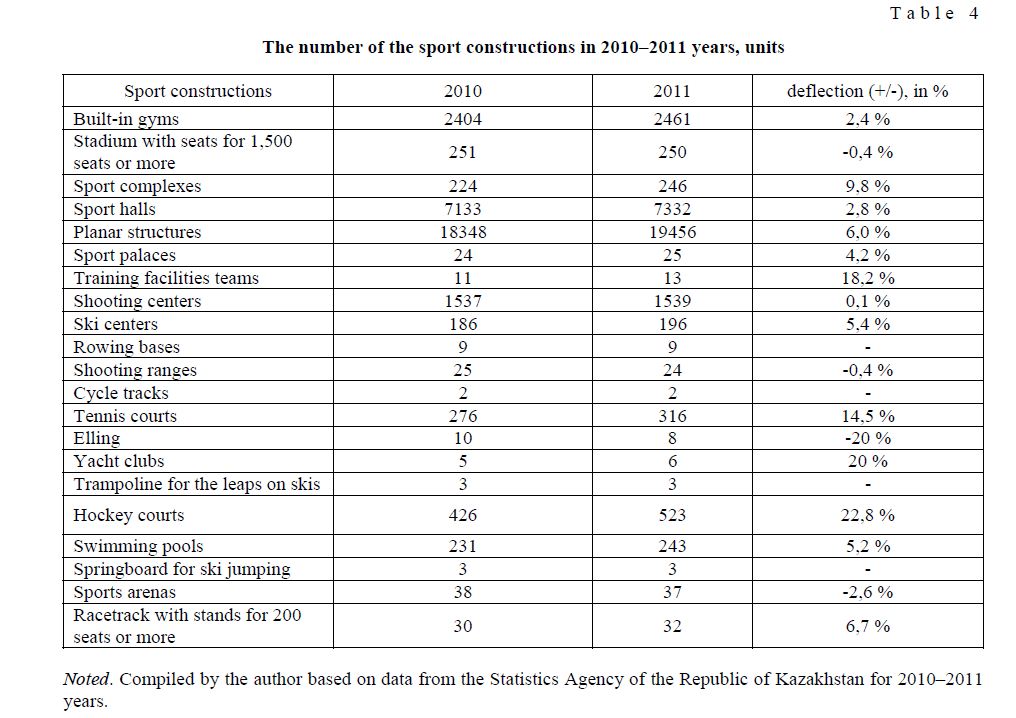In this paper the current state of the development of sports tourism in the Republic of Kazakhstan was shown. Statistical analysis of the main indicators of the development of sports tourism in the country was shown, in particular the number of sports organizations and institutions, the staff of sports tourism, the number of sports facilities and ski resorts were shown. Regionally reflect the development potential of sports tourism in Kazakhstan — denotes the number of people regularly engaged in physical culture and sports.
Kazakhstan has a huge potential for the development of sports tourism. Here is the amazing variety of landscapes, climate, and geographical zones. All this gives visitors the opportunity to have a large selection of outdoor activities: hiking, mountain hiking, skiing, horseback riding, cycling and much more.
Spread abroad extreme kinds of sport tourism, there are: rafting, scuba diving, mountain biking, rally and many more in Europe, Asia, United Arab Emirates, Egypt, and New Zealand. In Kazakhstan, these species are not sufficiently developed, but are a prospect for the future.
Customer benefits of sports tourism supported practical utility of the greater part of the Republic of Kazakhstan for sport tourism events
Natural landscapes of Kazakhstan are characterized like a rock-alpine glacier, mountain landscapes, hummocky arrays, steppe, steppe, desert and semi-desert, and a host of water resources.
Sports tourism in Kazakhstan is represented by the following species: hiking — tourists hike on flat and rough terrain, ski tourism is a trip to the mountains on the slopes, ridges, glaciers, mountain passes with skis.
Climbing is a kind of sports tourism, the main purpose of putting on the ascent of the mountain peaks.
Climbing consider an extreme sport, as it is associated with real dangers — climbing up steep slopes and ridges, crevices, cracks, and the risk of falling into avalanches, rockslides, mudslides — in bad weather, low air pressure and high solar radiation.
Especially extreme climbing is in the winter; cycling — is traveling and trekking bicycles on the plains, ravines, sand, mountain trails, rivers (ford) on the road, sports, mountain biking, boating — hiking along the rivers, lakes, seas and reservoirs in inflatable boats (rafts), collapsible kayaks, pedal boats, rafts, and more.
Water tourism is well developed in large lowland rivers and traversed by mountain rivers.
Also popular «Around the World» is water tours that begin and end in the same place; sailing tourism — traveling under sail that is sailing — is carried out on the lakes, rivers, trip riding — horse riding — has a curative effect.
Most horse routes passes through forest and mountain trails, prairies, meadows and fields, ravines and along rivers and lakes; caving involves visiting natural or man-made caves and mazes. It is interesting for a variety of terrain, creating obstacles to the passage (wells, obstructions, narrow slit, underground rivers, etc.), as well as extreme — adverse — the physical conditions (high humidity and lack of natural light).
All this adds an element of adventure caving in; -auto, -moto tourism is a traveling in cars, motorcycles, mopeds on asphalt and dirt road.
Today, tourist organizations of Kazakhstan developed exciting and promising route of sports tourism.
Without demand for sport tourism development can not ski tourism. In Kazakhstan, the potential of sports tourism is great, as shown in table 1 [1; 111].
T a b l e 1
The potential of sport tourism (number of people regularly engaged in physical culture and sports, in thousands)

According to the table, it should be noted that the greatest increase in this indicator was observed in Aktobe and Atyrau regions, amounting to 40,4 % and 25,4 %, respectively. The smallest growth rates being analyzed in Almaty, reaching — 8,2 %.
Figure 1 shows the region's share of the number of people regularly engaged in physical culture and sports.

Figure 1. The region's share in the development of sports tourism in 2011 year, %
Figure 1 shows that the most sports, sports tourism and physical culture in Almaty, Karaganda and South Kazakhstan — 11,6 %, 11,0 % and 10,8 %, respectively. In other regions of the contribution to the development of sports tourism less than 10 % [1; 112–113].
The number of the sport organizations and constructions, units
T a b l e 2

Noted. Compiled by the author based on data from the Statistics Agency of the Republic of Kazakhstan for 2010–2011 years.
Analyzing Table 2, it must be concluded that the unchanged number of Olympic training centers and centers for the training of Olympic reserve. But at the same time, according to indicators such as — number of sports clubs, including professional in 2011 year, a growth rate of 27,8 % and 45,1 %, respectively.
Important for the development of sports tourism is training. Table 3 presents the analysis of this indicator over 2010–2011 years [1; 113].
T a b l e 3
The number of the personnel in a brunch of physical culture, sport and sport tourism, persons

Noted. Compiled by the author based on data from the Statistics Agency of the Republic of Kazakhstan for 2010–2011 years.
According to Table 3, in 2011 year compared to 2010 year, the number of personnel in the field of physical culture, sport and sport tourism has increased by an average of 8,7 %. It should be noted the growth promotion of tourism, as evidenced by the steady growth of instructors, supervisors in 2011 year.
Table 4 shows the number of sports facilities in 2010–2011 years [1; 72, 73].
The number of the sport constructions in 2010–2011 years, units
T a b l e 4

Noted. Compiled by the author based on data from the Statistics Agency of the Republic of Kazakhstan for 2010–2011 years.
Analyzing the data in Table 4, it can be concluded that, in general, for this indicator there is a progressive trend. Exceptions are only indicators such as stadiums with stands for 1,500 seats or more (-0.4 %), the number of shooting ranges (-0.4 %) and facilities for the boathouse (-20 %) and the number of sports arenas (2.6 %). It should also be noted that the reduction in the number of jumps due to the fact that, in connection with the seven Asian Winter Games in 2011, were reconstructed old-style jumps and building new, fully meeting all international standards. As for reducing the number of skating tracks with natural ice, it is, first of all, due to the fact that they have been replaced with skating tracks with artificial ice (Table 5) [1; 75].
The number of ski resorts by ownership for the period 2008–2011 years, units
T a b l e 5

Noted. Compiled by the author based on data from the Statistics Agency of the Republic of Kazakhstan for 2010–2011 years.
According to the statistics, in 2011 years, 89, 8 % (176 units) ski lodges owned by the state, whereas only 10,2 % (20 units) owned by private property. Overall, there is a positive trend to increase the number of ski bases for all forms of ownership.
On the basis of statistical data shows that the largest number of ski centers located in Karaganda (83 units — 41 %), Kostanai (39 units — 19 %), East Kazakhstan (26 — 13 %), North Kazakhstan (16 points — 8 %) and Akmola (11 units — 6 %) regions. In other regions, is located less than 10 ski resorts, or they are not there (Figure 2).
Kazakhstan has an abundance of natural resources available for the development of all types of sports tourism, including the extreme. In Kazakhstan are many beautiful tourist spots that are suitable for the organization of this type of tourism, but many not been studied and researched. Natural and recreational resources of Kazakhstan, as well as national traditions and characteristics, the mentality, customs have attractiveness to foreign tourists, as they have already filled offered tourist services in the markets of Europe and Asia. With appropriate government support is possible to study the unexplored places of natural landscapes of Kazakhstan for the construction of new, interesting sport routes, which popularize sport tourism globally.
Before the collapse of the Soviet Union there was a so-called golden age of amateur sports tourism. While Kazakhstan tourists annually make an average of 180 trips 6,1 grade, which were attended by about 1680 people. In 1991 year he began to dry out, and in 1992 year a complete halt financial support for athletic trips, new states, borders, customs, currencies, and the main economic challenges, faced by the people. All contributed to the slide down the volume trekking. If tourists in 1990 year Kazakhstan was passed 204 hike of all levels of difficulty (1806 participants), in 1996 year, took only 15 such trips at 105 participants. 1996 year was a turning point in the development of sports tourism, was passed the lowest point of his catastrophic collapse.

Figure 2. The share of ski bases in the regions of Kazakhstan in 2011 year, %
After that the positive growth in the number of sports tours from 1996 year to 2000 year. Although this amount was not able to restore the pre-reform level of development of sports tourism, but it was already significant progress in comparison with the period of the «Great Depression» beginning of the 1990s. Tourists again became engaged in sport forms of tourism, even in spite of numerous economic problems.
Consider each of the most popular types of active sports tourism in more detail.
Hiking. Stem form of tourism, the most accessible for study, the most popular type, which is confirmed by the numerous trips and no categories weekend trips. Kazakhstan has good conditions for its development. In the southern and eastern regions of the country can be carried out hiking the highest levels of difficulty. In the structure of classified trekking it in second place, its share 20,5 %, in the year takes about 50 trips, which was attended by about 350 people. Is cultivated in almost all tourist businesses, clubs and groups. Recent moves sports component, reflected in the growth of Category routes, results presentations at the championships, conferring workshops and instructional titles [2].
Ski tourism. Has good potential for development, but there is no organizing principle. The share is 4,9 %. Challenging hikes occur in the minimum amount of: a hike in average for 2,5 years.
Mountaineering. Most expensive to organize trips initial levels of difficulty that the economic conditions of the 1990s led to the loss of previously accumulated cruising potential. Largest share of trips (members) — 12,4 (12,3) form the 3rd place, but it is the most titled in rank and medals competitions attributable to a relatively small contingent of students. Cultivated in the southern, eastern and central regions of Kazakhstan. In the past two years, increased the number of committed trekking 2,1 grade. Sluggish stagnation gave way at an acceptable pace of growth of fixed marching components. Kazakhstan is well positioned for the development of ski tourism, especially in the southern and eastern regions, where the ski resorts such as Chimbulak, Medeo, Tabagan and others. Ski Resorts directly affect the revenue from sports types of tourism
Boating. Have opportunities for development in East Kazakhstan, though not the entire season, but you can pass routes high degrees of complexity. To date, the most popular species is categorized by the number of trips and their members: the number of making annual trips close to 100, which involved about 700 people. Share in the total camp kitty is 43 % (46.5 %). However, in the last year has been replaced by a positive trend slipping down and volume of sports trips, and the number of participants.
Cycling. It has very good conditions for development in virtually all regions of Kazakhstan can be done bike trips of various degrees of complexity, and to develop its extreme forms, such as mountain biking. Its share of 7 % [3].
Automoto tourism. The share of auto-moto hikes of 4,9 %. In recent years, takes an average of about 12 routes per year with up to 100 people. Perspective combined trips — combination with other forms of tourism, when a car component of a campaign — it's entrance and exit from the area in which the route passes other species directions. The auto trips are developed, when its course get to tour or visit other facilities and leisure activities.
Equestrian tourism. This type of tourism is not listed in the above table, as categorized trips to Kazakhstan almost were not; it is presented in the form of hikes of the day and non categories hikes. In the last three years, he is very popular. Further development of this type of tourism is possible with the restoration of commercial interest to him.
In addition to the classic forms of tourist trekking representatives of Kazakhstan committed unusual, unconventional or previously have not practiced travel with extreme content as the technology to overcome obstacles, and on the conditions of the route: single trekking, rafting in Kazakhstan, Europe and Asia.
The course of development of sports tourism since Kazakhstan gained independence indicates that the process is not spontaneous, but is the result of joint efforts of the tourism assets of the country. Since that time, managed to turn out a good basis for further effective development of sports tourism, store experience, traditions accumulated in previous times. All this is a prospect for the development of sports tourism in Kazakhstan.
The share of organized sports tourism, among other types of tourism is negligible, but the positive dynamics of development of sports tourism and the increasing number of participants. The most popular kinds of sports tourism in Kazakhstan are water, hiking and mountaineering. In general, income from tourism, including sports, obtained tourist firms increases, but income derived ski tourist bases, has a negative trend. This suggests the weak development of the infrastructure. Based on the overall analysis of sports tourism in Kazakhstan revealed multiple perspectives for the development of this type of tourism.
References:
- Tourism in Kazakhstan 2007–2011 / Statistical Yearbook / Astana,
- http://tourmuseum.ru/russia/2007-carov-konf/2007-carov-konf-kiselev.htm
- http://ecotourism.kz/velosipednyie/3.html